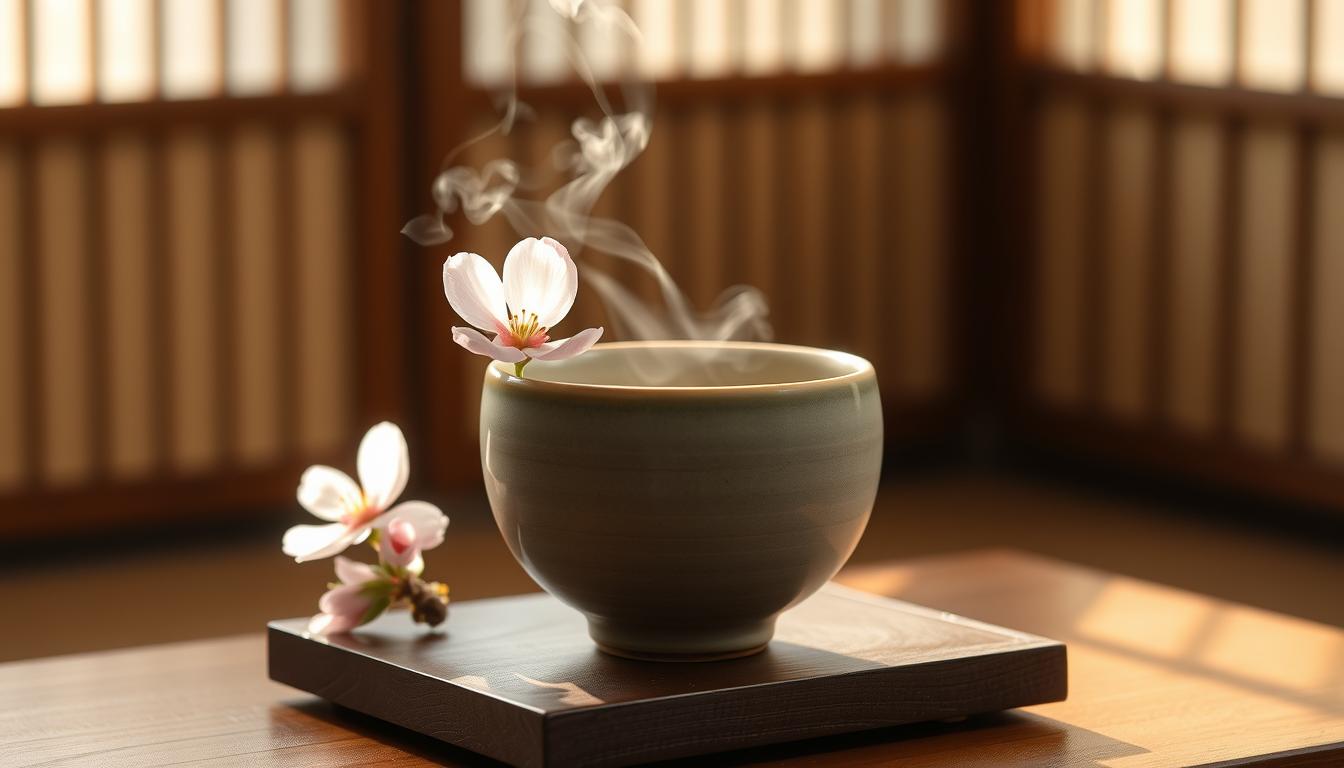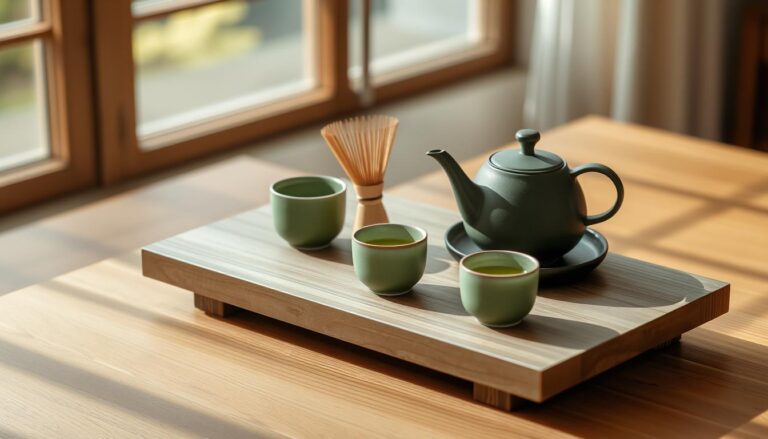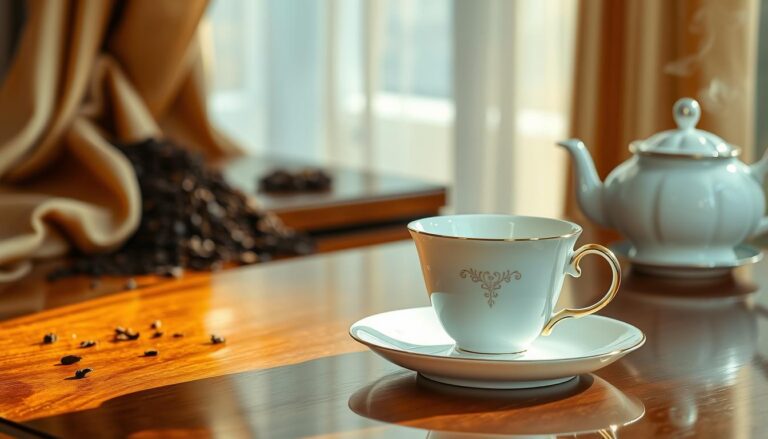Exquisite Japanese Tea Cup: A Timeless Tradition
The first time I held a traditional Japanese tea cup, I felt a deep connection. These cups are not just ordinary. They tell stories of tradition, made with care and soul, making every sip special.
Japanese tea cups are more than just cups. They connect you to a long history of tea lovers. Each cup has its own story, showing the skill and spiritual depth of Japanese culture.
Exploring Japanese tea cups opens a world where design meets purpose. These beautiful cups are made to improve your tea experience. They come in many materials, each with its own tale to tell.
Table of Contents
Key Takeaways
- Japanese tea cups are more than drinking vessels—they’re cultural artifacts
- Each cup represents centuries of artistic and spiritual tradition
- Design and functionality are equally important in tea cup creation
- Materials and craftsmanship significantly impact the tea drinking experience
- Traditional tea cups connect modern drinkers with ancient cultural practices
The Art of Japanese Tea Ceremony
The Japanese tea ceremony is more than just making tea. It’s a deep cultural experience that goes beyond the drink. It’s a meditation that celebrates mindfulness and connection.
The ceremony is based on four key principles: harmony, respect, purity, and tranquility. Every movement shows deep thoughts on human connection and self-awareness.
Understanding Tea’s Cultural Significance
In Japan, tea is more than a drink. It connects people, creating real moments of understanding. The ceremony turns a simple tea cup into a symbol of culture.
- Represents spiritual meditation
- Promotes mindful social interactions
- Demonstrates artistic precision
- Honors centuries-old traditions
Ritual Practices and Etiquette
“The tea ceremony is a way of achieving harmony through simplicity and respect.” – Traditional Japanese Proverb
Tea ceremony participants follow strict rules. Every action, from making tea to serving guests, is done with care. The tea cup is a key part of this, showing beauty and spiritual values.
Tea Cup’s Symbolic Role
The tea cup in the ceremony is more than a cup. It symbolizes Japan’s values. Its design and feel talk about change, beauty, and connection between people.
Types of Japanese Tea Cups
Japanese tea culture is rich in unique tea cup designs. These cups reflect centuries of craftsmanship and tradition. Each cup is not just for tea but also a piece of Japanese heritage.
Japanese tea cups come in many styles, each with its own beauty and purpose. Knowing about these styles helps us appreciate the art of Japanese tea drinking.
Matcha Bowls: Artistic Vessels of Tradition
Matcha bowls, or chawan, are the top in tea cup art. They are wide and deep for matcha green tea. Their design helps whisk the tea into a smooth, frothy drink.
- Typically hand-crafted by skilled artisans
- Feature wide, open mouths for whisking
- Come in various colors and decorative patterns
Yunomi: Everyday Tea Companions
Yunomi cups are the most common in Japanese daily life. Unlike Western cups, they have no handles and are simple. You’ll find yunomi in different sizes and materials, each with its own design.
“A yunomi is more than a cup; it’s a connection to Japanese daily life and tea culture.” – Tea Master Hiroshi Yamada
Chawan: Ceremonial Masterpieces
Chawan bowls are the most honored in Japanese culture. Used in traditional tea ceremonies, they are crafted to show beauty, harmony, and spiritual meaning.
Whether you love tea or explore cultures, learning about Japanese tea cups is fascinating. It shows how function and art come together.
Materials Used in Japanese Tea Cups
Finding the right material for a Japanese tea cup changes how you enjoy tea. These cups are more than just containers. They are cultural treasures made with care and purpose.
The choice of materials is key for a great tea experience. Each material affects the taste, temperature, and look of the tea.
Porcelain vs. Earthenware: Understanding the Differences
In authentic Japanese tea cups, porcelain and earthenware are the top choices. They offer different experiences for tea lovers.
- Porcelain: Delicate, smooth, and translucent
- Earthenware: Rustic, porous, and heat-retaining
The Role of Glazes in Tea Cups
Glazes turn simple tea cups into beautiful art. They protect the cup and add color and texture.
| Glaze Type | Characteristics | Visual Appeal |
|---|---|---|
| Celadon | Smooth, jade-like finish | Soft green tones |
| Shino | Milky white with iron speckles | Rustic, traditional look |
| Tenmoku | Dark, rich metallic glaze | Deep brown with subtle variations |
Sustainable Materials: A Modern Approach
Today, Japanese tea cup makers use eco-friendly materials. Sustainable crafting shows respect for tradition and the planet.
“The material of a tea cup tells a story older than words.” – Japanese Tea Master
When picking a vintage tea cup, think about its history, use, and beauty. Each cup holds a part of Japanese culture.
The Aesthetic of Japanese Tea Cups
Japanese tea cups are more than just for drinking. They show deep artistic value, blending minimalist design with natural beauty. They open a window into Japan’s rich culture.
Japanese tea cups balance form and function beautifully. Each curve and texture has a story. They turn a simple tea moment into a spiritual experience.
Minimalistic Design: Embracing Simplicity
Minimalism in Japanese tea cup design is all about:
- Clean, uncluttered lines
- Neutral color palettes
- Purposeful imperfections
- Functional elegance
Influence of Nature on Tea Cup Designs
Nature deeply influences tea cup designs. Designers find inspiration in:
- Mountain landscapes
- Seasonal changes
- Organic textures
- Subtle color gradients
Customizing Your Tea Cup: Styles and Patterns
When picking a Japanese tea cup, think about these options:
- Traditional glazing techniques
- Hand-painted motifs
- Regional artistic styles
- Personal symbolic representations
Your tea cup collection can show your personal journey and love for Japanese craftsmanship.
Choosing the Right Japanese Tea Cup
Finding the perfect traditional tea cup is more than just picking a cup. It’s about understanding the details that make drinking tea special. This journey connects you with Japan’s rich tea culture.
When looking at handmade ceramic tea cups, several important factors help you choose. The right cup can make your tea time better and connect you with Japan’s long history.
Factors to Consider for Authenticity
Real Japanese tea cups are more than just for drinking. Look for these key things:
- Handcrafted details by skilled artisans
- Traditional manufacturing techniques
- Unique glaze and texture variations
- Regional design elements
Selecting Based on Tea Type
Each tea needs a special cup to bring out its best flavor. The shape of the cup greatly affects how you experience the tea.
| Tea Type | Recommended Cup Style | Ideal Cup Characteristics |
|---|---|---|
| Green Tea | Wide, shallow cup | Allows aroma dispersion |
| Matcha | Deep, wide-rimmed bowl | Enables whisking |
| Oolong | Tall, narrow cup | Concentrates fragrance |
Personalization: Finding Your Perfect Match
Your handmade ceramic tea cup should match your style and how you like to drink tea. Here are some tips:
- Think about your favorite teas
- Consider your hand size and grip
- Look at colors and designs you like
- Check the cup’s weight and balance
“A true tea cup is not just made, it is crafted with intention and soul.”
Choosing a tea cup is a personal journey. Take your time to explore different styles and craftsmanship. Find a cup that matches your taste and tea ritual.
Care and Maintenance of Japanese Tea Cups
Keeping your porcelain tea cup beautiful needs careful attention and special knowledge. Your vintage tea cup is more than a drinker—it’s a piece of cultural art that needs respect and gentle care.
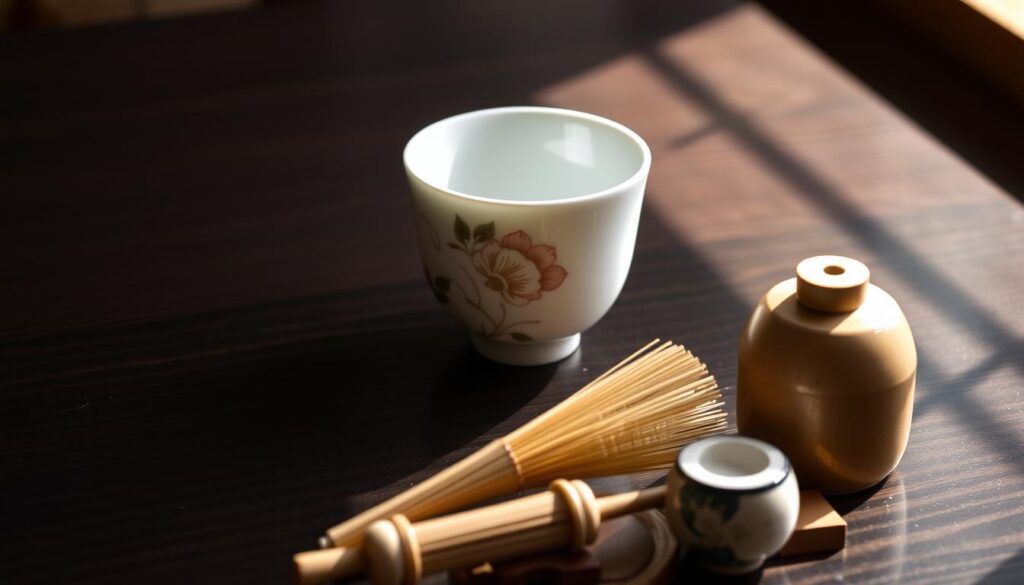

To keep your Japanese tea cups looking great, follow some key steps. These steps help protect their detailed design and keep them strong.
Cleaning Techniques for Longevity
Cleaning right is key to keeping your tea cups in top shape. Here’s what to do:
- Use lukewarm water with mild, non-abrasive soap
- Avoid harsh scrubbing tools like steel wool
- Gently hand wash each vintage tea cup
- Rinse thoroughly with clean water
- Pat dry with a soft, lint-free cloth
Strategic Storage Methods
Storing your porcelain tea cup needs careful thought. Keep your tea cups safe by:
- Placing cups in a dust-free cabinet
- Using soft cloth separators between cups
- Avoiding direct sunlight exposure
- Maintaining consistent room temperature
Preventing Common Damages
Prevention is always better than repair. Protect your delicate tea cups from damage by:
- Handling cups with clean, dry hands
- Avoiding sudden temperature changes
- Checking for existing hairline cracks before use
- Using soft surfaces when setting down cups
Treat your Japanese tea cup as a treasured artifact, and it will continue to bring beauty to your tea ceremonies for generations.
The Symbolism of Tea Cups in Japanese Culture
Japanese tea cups are more than just for drinking. They hold deep cultural meanings that link tradition, spirituality, and human bonds. In the Japanese tea ceremony, each cup shares a story of connection and respect.
Tea cups in Japanese culture are not just simple drinking vessels. They carry deep emotional and spiritual weight. They show the complex layers of communication in Japanese social interactions.
Tea Cups as Gifts and Tokens of Friendship
When choosing tea cups as gifts, Japanese people see them as symbols of:
- Deep respect
- Personal connection
- Cultural appreciation
- Shared experiences
The Journey of Tea Cups: Tradition and Heritage
Each tea cup tells a story of craftsmanship passed down through generations. Artisans create these vessels with great care. They put generations of knowledge into every detail, making them cultural treasures.
Spiritual Connections: Tea Cups in Zen Practices
In Zen philosophy, tea cups symbolize mindfulness and being present. The Japanese tea ceremony turns drinking tea into a meditative act. Every movement and interaction with the cup is a spiritual journey of simplicity and focus.
“A tea cup is not just an object, but a gateway to understanding oneself and the world.” – Zen Teaching
Popular Brands and Artisans
The world of authentic Japanese tea cups is filled with craftsmanship and tradition. It features both famous brands and passionate artisans. Japanese ceramic art is loved by tea lovers all over the world.
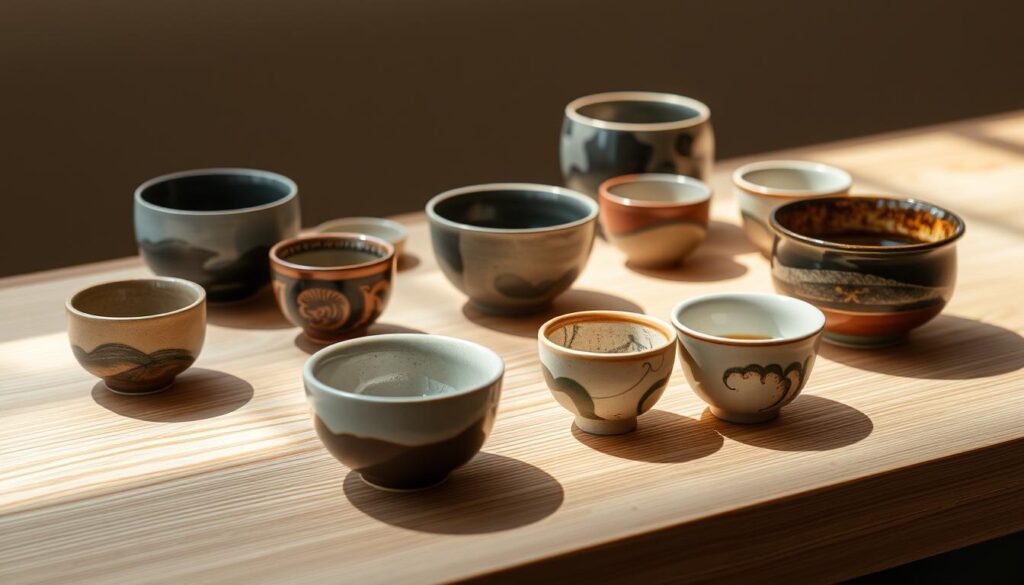

In Japan, many tea cup makers turn simple clay into amazing handmade cups. They carry on skills passed down through generations. Their work shows deep techniques and artistic vision.
Notable Japanese Brands Crafting Tea Cups
Many top brands are known for making outstanding tea cups:
- Tokoname Pottery Studio – Known for traditional earthenware designs
- Kyoto Ceramic Workshop – Specializing in delicate porcelain pieces
- Mashiko Pottery Center – Renowned for rustic, natural glazing techniques
Small Artisans and Their Unique Creations
Independent ceramic artists add their own special touch to tea cups. They often have unique styles that show their artistic side.
| Region | Artistic Style | Signature Technique |
|---|---|---|
| Hokkaido | Minimalist Design | Natural Stone Glazing |
| Ishikawa | Nature-Inspired Patterns | Hand-Carved Detailing |
| Okinawa | Coastal Aesthetic | Sea-Inspired Color Palettes |
How to Support Local Japanese Craftspeople
Supporting these artisans is more than just buying their work. Here are ways to really connect with their craft:
- Purchase directly from artisan workshops
- Attend ceramic exhibitions and craft fairs
- Share their stories on social media platforms
- Invest in authentic, handmade ceramic tea cups
By supporting these amazing craftspeople, you help keep Japanese culture alive. You also get to enjoy beautiful, handmade tea cups.
Where to Buy Authentic Japanese Tea Cups
Finding the perfect japanese tea cup is a journey. You can build a special collection with the right approach. Look for authentic pieces to make your collection unique.
Shopping around helps you find genuine Japanese tea cups. These cups show off traditional craftsmanship and cultural importance.
Online Retailers: Digital Marketplace for Tea Enthusiasts
Looking for authentic japanese tea cups online? Here are some top sites:
- Japan Design Store
- Kyoto Artisan Marketplace
- Rakuten Global Market
- Etsy Japanese Ceramics Shops
Local Stores: Discovering Nearby Treasures
Local stores can reveal hidden gems for your collection. Check out:
- Asian specialty markets
- Ethnic grocery stores
- Boutique tea shops
- Cultural import stores
Craft Fairs and Art Shows: Unique Shopping Experiences
Craft fairs are great for meeting artisans and seeing tea cups up close.
| Event Type | Potential Finds | Authenticity Guarantee |
|---|---|---|
| Local Craft Fairs | Handmade ceramics | Direct artist interaction |
| Japanese Cultural Festivals | Traditional designs | Cultural certification |
| Artisan Markets | Unique, limited editions | Provenance documentation |
Pro tip: Always check the authenticity of your japanese tea cup. Look for provenance, maker’s marks, and expert verification before buying.
The Global Influence of Japanese Tea Culture
Japanese tea culture has spread far beyond Japan, winning hearts of tea lovers everywhere. It’s known for its deep traditions and special tea cup designs. This has led to a cultural exchange that links Eastern and Western tea practices.
People around the world love Japanese tea culture for more than just the tea. They admire the craftsmanship, mindfulness, and beauty in each traditional tea cup.
Japanese Tea Cups: A Global Phenomenon
Tea fans worldwide are exploring Japanese tea cup traditions in many ways:
- Cultural exchange programs
- International tea ceremonies
- Workshops and educational seminars
- Online global tea communities
Fusion of Design: East Meets West
Today, designers are mixing traditional Japanese styles with modern Western touches. This creates new tea cups that attract people looking for both cultural depth and modern flair.
The Popularity of Japanese Tea Ceremonies in the U.S.
In the U.S., there’s a growing interest in Japanese tea ceremonies. People are drawn to the meditative and mindful aspects of these rituals. They see these ceremonies as a way to connect with culture on a deeper level.
“Tea is a way of restoring harmony and balance in our fast-paced world.” – Tea Cultural Expert
Conclusion: Embracing the Tradition of Japanese Tea Cups
Your journey into Japanese tea cups shows more than just pretty cups. These cups connect you to centuries of mindful traditions. Each cup shares a story of art, precision, and spiritual bond.
The Japanese tea ceremony turns tea drinking into a meditative act. Exploring styles like chawan and yunomi, you see how each cup adds its own charm. Your bond with these cups is more than looks—it’s about a deep cultural heritage.
Reflecting on Personal Rituals
Using these cups daily makes you more mindful of your tea time. Choosing an authentic Japanese tea cup is a personal quest. It’s about finding your own style and connection to this ancient tradition.
Whether you like simple porcelain or rustic earthenware, each cup encourages you to slow down. It invites you to enjoy the present moment.
Keeping Tradition Alive
Today’s tea lovers can keep the Japanese tea ceremony alive while making it our own. By honoring traditional ways and trying new things, we keep this beautiful tradition alive. Our love for these tea cups connects us to the past and the present.

